Chart of accounts
Introduction to Chart of Accounts
A chart of accounts is a listing of the names of the accounts that a company has identified and made available for recording transactions in its general ledger. A company has the flexibility to tailor its chart of accounts to best suit its needs, including adding accounts as needed.
Within the chart of accounts you will find that the accounts are typically listed in the following order:

Within the categories of operating revenues and operating expenses, accounts might be further organized by business function (such as producing, selling, administrative, financing) and/or by company divisions, product lines, etc.
A company's organization chart can serve as the outline for its accounting chart of accounts. For example, if a company divides its business into ten departments (production, marketing, human resources, etc.), each department will likely be accountable for its own expenses (salaries, supplies, phone, etc.). Each department will have its own phone expense account, its own salaries expense, etc.
A chart of accounts will likely be as large and as complex as the company itself. An international corporation with several divisions may need thousands of accounts, whereas a small local retailer may need as few as one hundred accounts.
Sample Chart of Accounts For a Large Corporation
Each account in the chart of accounts is typically assigned a name and a unique number by which it can be identified. (Software for some small businesses may not require account numbers.) Account numbers are often five or more digits in length with each digit representing a division of the company, the department, the type of account, etc.
As you will see, the first digit might signify if the account is an asset, liability, etc. For example, if the first digit is a "1" it is an asset. If the first digit is a "5" it is an operating expense.
A gap between account numbers allows for adding accounts in the future. The following is a partial listing of a sample chart of accounts.
- Current Assets (account numbers 10000 - 16999)
- 10100 Cash - Regular Checking
10200 Cash - Payroll Checking
10600 Petty Cash Fund
12100 Accounts Receivable
12500 Allowance for Doubtful Accounts
13100 Inventory
14100 Supplies
15300 Prepaid Insurance - Property, Plant, and Equipment (account numbers 17000 - 18999)
- 17000 Land
17100 Buildings
17300 Equipment
17800 Vehicles
18100 Accumulated Depreciation - Buildings
18300 Accumulated Depreciation - Equipment
18800 Accumulated Depreciation - Vehicles - Current Liabilities (account numbers 20000 - 24999)
- 20100 Notes Payable - Credit Line #1
20200 Notes Payable - Credit Line #2
21000 Accounts Payable
22100 Wages Payable
23100 Interest Payable
24500 Unearned Revenues - Long-term Liabilities (account numbers 25000 - 26999)
- 25100 Mortgage Loan Payable
25600 Bonds Payable
25650 Discount on Bonds Payable - Stockholders' Equity (account numbers 27000 - 29999)
- 27100 Common Stock, No Par
27500 Retained Earnings
29500 Treasury Stock - Operating Revenues (account numbers 30000 - 39999)
- 31010 Sales - Division #1, Product Line 010
31022 Sales - Division #1, Product Line 022
32015 Sales - Division #2, Product Line 015
33110 Sales - Division #3, Product Line 110 - Cost of Goods Sold (account numbers 40000 - 49999)
- 41010 COGS - Division #1, Product Line 010
41022 COGS - Division #1, Product Line 022
42015 COGS - Division #2, Product Line 015
43110 COGS - Division #3, Product Line 110 - Marketing Expenses (account numbers 50000 - 50999)
- 50100 Marketing Dept. Salaries
50150 Marketing Dept. Payroll Taxes
50200 Marketing Dept. Supplies
50600 Marketing Dept. Telephone - Payroll Dept. Expenses (account numbers 59000 - 59999)
- 59100 Payroll Dept. Salaries
59150 Payroll Dept. Payroll Taxes
59200 Payroll Dept. Supplies
59600 Payroll Dept. Telephone - Other (account numbers 90000 - 99999)
- 91800 Gain on Sale of Assets
96100 Loss on Sale of Assets Sample Chart of Accounts for a Small Company
This is a partial listing of another sample chart of accounts. Note that each account is assigned a three-digit number followed by the account name. The first digit of the number signifies if it is an asset, liability, etc. For example, if the first digit is a "1" it is an asset, if the first digit is a "3" it is a revenue account, etc. The company decided to include a column to indicate whether a debit or credit will increase the amount in the account. This sample chart of accounts also includes a column containing a description of each account in order to assist in the selection of the most appropriate account.
Asset Accounts
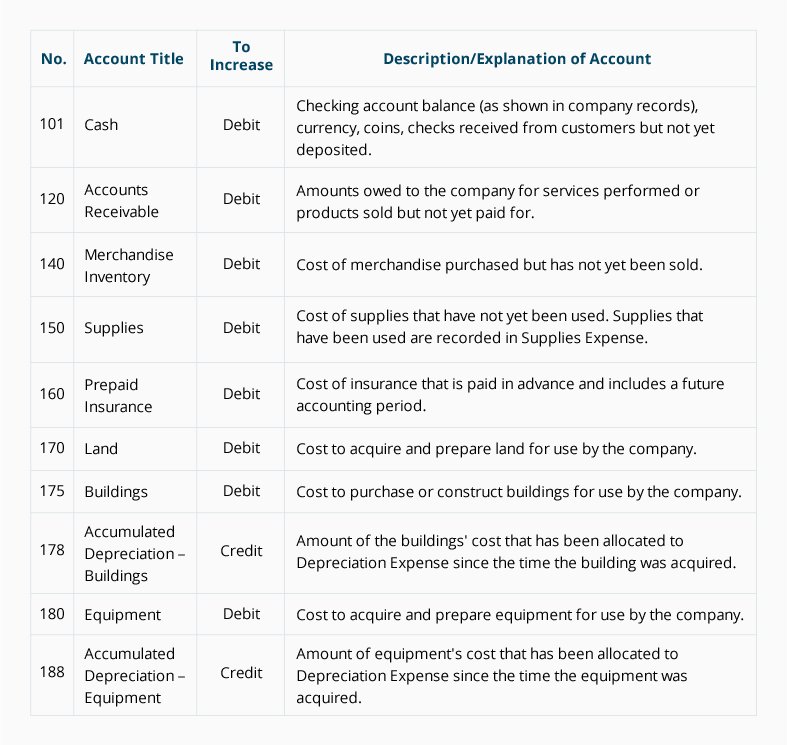
Liability Accounts
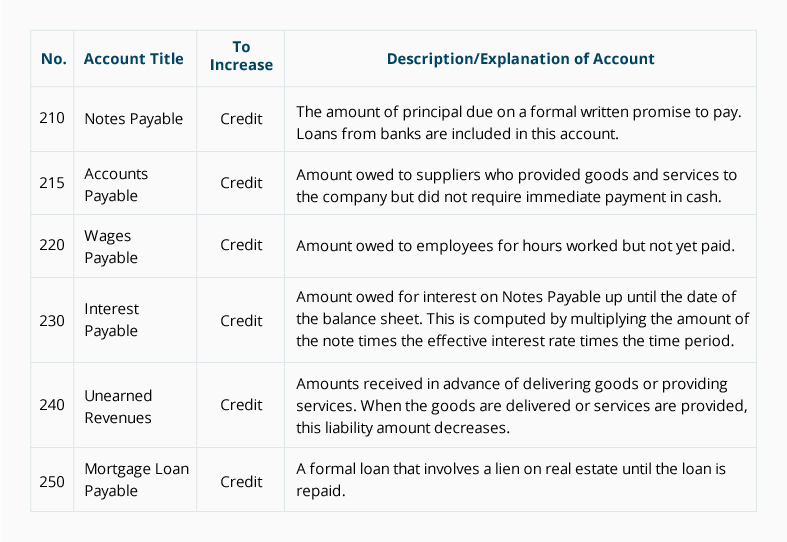
Owner's Equity Accounts
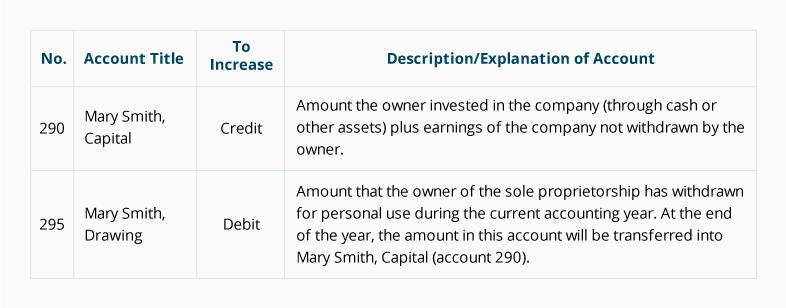
Operating Revenue Accounts

Operating Expense Accounts
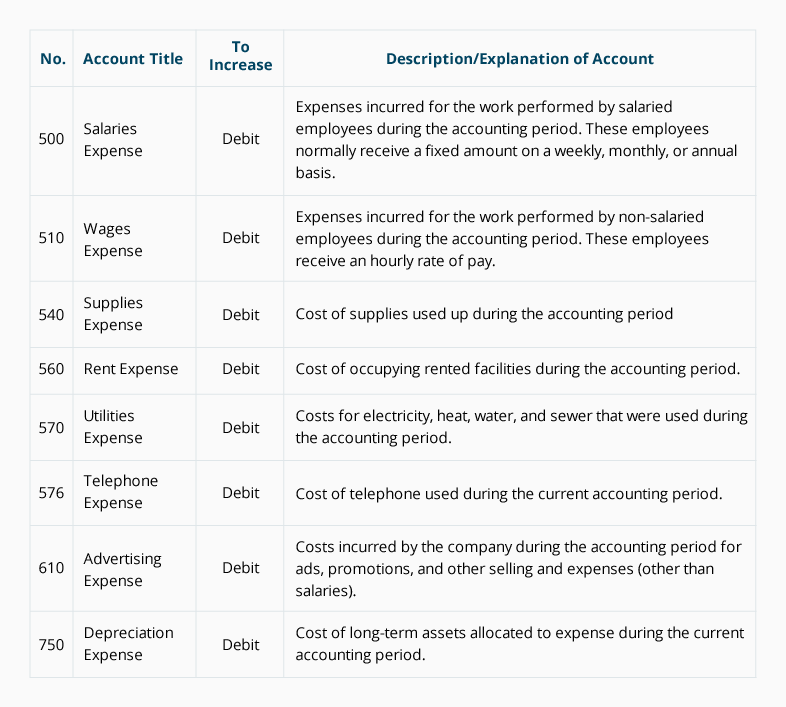
Non-Operating Revenues and Expenses, Gains, and Losses
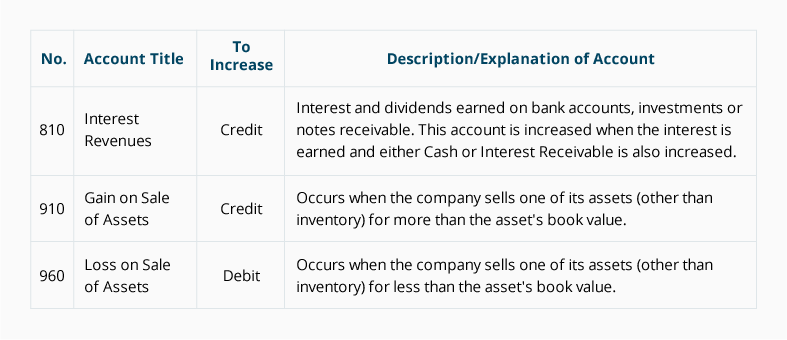
Accounting software frequently includes sample charts of accounts for various types of businesses. It is expected that a company will expand and/or modify these sample charts of accounts so that the specific needs of the company are met. Once a business is up and running and transactions are routinely being recorded, the company may add more accounts or delete accounts that are never used.
At Least Two Accounts for Every Transaction
The chart of accounts lists the accounts that are available for recording transactions. In keeping with the double-entry system of accounting, a minimum of two accounts is needed for every transaction—at least one account is debited and at least one account is credited.
When a transaction is entered into a company's accounting software, it is common for the software to prompt for only one account name—this is because the software is programmed to automatically assign one of the accounts. For example, when using accounting software to write a check, the software automatically reduces the asset account Cash and prompts you to designate the other account(s) such as Rent Expense, Advertising Expense, etc.
Some general rules about debiting and crediting the accounts are:
- Expense accounts are debited and have debit balances
- Revenue accounts are credited and have credit balances
- Asset accounts normally have debit balances
- To increase an asset account, debit the account
- To decrease an asset account, credit the account
- Liability accounts normally have credit balances
- To increase a liability account, credit the account
- To decrease a liability account, debit the account
- Quiz:
1. The chart of accounts is a listing of the accounts presently having balances in the general ledger.
- True False
- 2.
Some accounting software will classify some accounts as "income" accounts, while accountants might refer to these accounts as "revenue" accounts.
True False
- 3.
The digits of the account numbers assigned to general ledger accounts often have significance. For example, an account number beginning with a "1" might signify that the account is an asset account, a "6" might signify an operating expense, etc.
True False
- 4.The accounts shown in the chart of accounts can be broadly classified into two categories: balance sheet accounts and __________ accounts.
- 5.
Every transaction will affect how many accounts?
Only one Only two Two or more
- 6.In addition to the standard chart of accounts for a specific industry, you will likely want to expand and/or modify the chart of accounts to fit your business. One tool that would be helpful in determining the accounts for your company would be your company's _____________ chart.
- 2.

This comment has been removed by the author.
ReplyDelete1. False
ReplyDelete2. true
3. true
4. Income statements
5. Two Or More
6. organization
By Renzo Jhair
Delete1.-False
ReplyDelete2.-True
3.-True
4.-income statement
5.-Two or more
6.- organization
By Farid Pinedo
This comment has been removed by the author.
ReplyDeleteBy: Jeff echevarria
ReplyDelete1.-False
2.-True
3.-True
4.-income statement
5.-Two or more
6.- organization
This comment has been removed by the author.
ReplyDelete1.-False
ReplyDelete2.-True
3.-True
4.-income statement
5.-Two or more
6.- organization
by Cristian calle
By: (Jose rafael)
ReplyDelete1- *False
2- *true
3- *true
4- *Income statements
5- *Two Or More
6- *Organization
ReplyDelete1) FALSE
2) TRUE
3) TRUE
4) INCOME STATEMENTS
5) TWO OR MORE
6) ORGANIZATION
By: Felix Ramìrez
by: Nicolle Viena Pezo.
ReplyDelete1. False.
2. True.
3. True.
4. Income statements.
5.Two or more.
6. Organization.
1)False
ReplyDelete2)True
3) True
4) income statements
5) Two or more
6)two
by:Jesús Huaman
This comment has been removed by the author.
ReplyDelete1. False
ReplyDelete2. True
3. False
4. Income Statements
5. Two or more
6. Organize
By: Damaris Alvites
1. False
ReplyDelete2. True
3. True
4. Income statements
5. Two or more
6. Organization
By: Rocio Sanchez
BY : Yeni Perez
ReplyDelete1: FALSE
2: TRUE
3 :TRUE
4:INCOME ATATEMENTS
5:TWO OR MORE
6:ORGANIZATION
1. False
ReplyDelete2. true
3. true
4. Income statements
5. Two Or More
6. organization
By: Frank Tantarico
Quiz:
ReplyDeleteanswers ( by: Josue Edwin Fernandez )
1. ( False)
2. ( True)
3. ( True)
4. ( Income statement accounts)
5. ( Only Two)
6. (Accounting software)
1. false
ReplyDelete2. true
3. true
4. Income statement
5. only or more
6. organization
(by gisela vargas)
(By:Lily Carrasco)
ReplyDelete1).True
2).true
3).true
4). Income Statements
5).Two or More
6).organization chart
1. False
ReplyDelete2. True
3. False
4. Income statements
5. Two or more
6. Organization
(By:Ruth Chanchari)
1. False.
ReplyDelete2. True.
3. Falso.
4. Income statement.
5. Two or more.
6. Organization.
By Widman Rodriguez.
ReplyDelete1.
False
2.
True
3.
True
4.
income statement accounts
5.
Only two
6.
Accounting software
1. False
ReplyDelete2. True
3. True
4. Income Statement
5. Two or more
6. Organization
By. Noli Cubas
1) V
ReplyDelete2) V
3) V
4) INCOME STATEMENT ACCOUNTS
5) ONLY TWO
6) ORGANIZATION
BY : MAGDIEL BOCANEGRA
1.false
ReplyDelete2.true
3.true
4. Income statements
5.two or more
6.organization
By(Juanita Tocas )
ANSWERS - By: Alessandro Gomez
ReplyDeleteI._ False
II._ True
III._ True
IV._ Income statements
V._ Two Or More
VI._ organization
Linda Stefany Gutarra Pezo
Delete1. False.
2. True.
3. True.
4. Income statements.
5.Two or more.
6. Organization.
This comment has been removed by the author.
ReplyDelete(by Keisy Mylene López)
ReplyDelete1. False.
2. True.
3. True.
4. Income statement.
5. Two or more.
6. Organization.
BY - DEANELLI JULCA RODRIGUEZ
ReplyDelete1. false
2. true
3. true
4. income statement accounts
5. two or more
6. organization
1.False
ReplyDelete2.True
3.True
4. Income statement accounts
5. Two Or More
6. Accounting software
by. giovany castillo